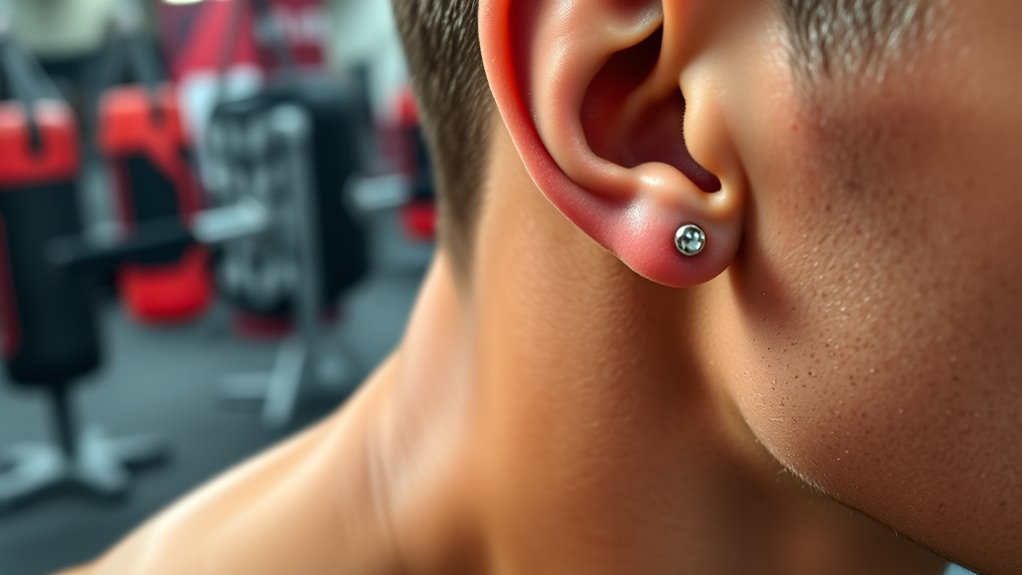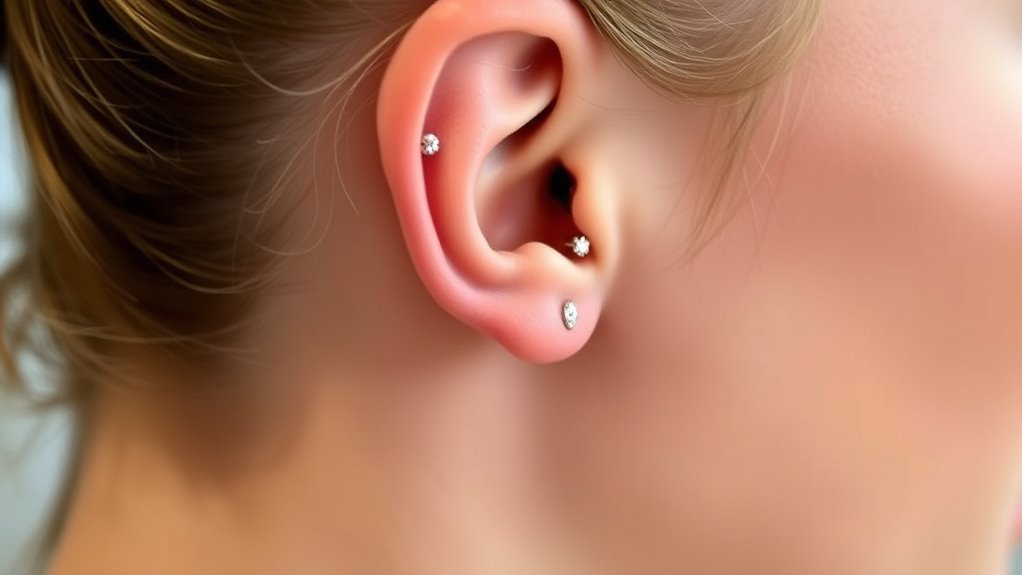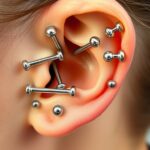If you have piercings and play sports, choosing secure, smooth jewelry like studs or hoops made from hypoallergenic materials such as surgical steel or titanium is essential to prevent snagging and irritation. Avoid dangling jewelry, especially during contact or high-impact activities, and consider removing or protecting piercings to lower injury risk. Proper hygiene, including cleaning with saline and showering after workouts, also helps prevent infections. Keep exploring for more tips on keeping your piercings safe while staying active.
Key Takeaways
- Choose secure, smooth-edged jewelry like studs or hoops to prevent snagging during sports activities.
- Remove or cover jewelry during high-impact or contact sports to minimize injury risk.
- Opt for hypoallergenic materials such as surgical steel, titanium, or gold to reduce irritation and allergic reactions.
- Follow proper hygiene routines, including cleaning with saline solution, to prevent infections around piercings.
- Consider piercing placement carefully, avoiding high-risk areas like cartilage or sensitive zones during vigorous activities.

Getting piercings as an athlete can be exciting, but it’s important to take into account how they might affect your training and safety. One of the main concerns is the risk of sports injuries. Piercings, especially those in visible areas like ears, eyebrows, or lips, can sometimes snag on clothing, equipment, or even your own skin during intense activity. This can cause painful tears or infections, setting back your progress and risking serious complications. To prevent this, choose jewelry that’s secure and appropriate for active lifestyles, like studs or hoops with smooth edges, and avoid dangling pieces that could catch or get pulled.
Hygiene practices are critical when you have piercings, particularly as an athlete. Sweat, dirt, and bacteria can easily get trapped around the jewelry, increasing the chances of infection. If you don’t maintain proper cleaning routines, you risk developing painful swelling, redness, or even more serious infections that could sideline you for weeks. After getting a piercing, you should follow your piercer’s instructions diligently, which usually include cleaning the area twice a day with a saline solution and avoiding touching or twisting the jewelry unnecessarily. Showering immediately after workouts to rinse away sweat and bacteria is also a smart habit. Additionally, selecting jewelry made from hypoallergenic materials like surgical steel, titanium, or gold can help minimize allergic reactions and irritation.
It’s essential to be mindful of how your piercing interacts with your training gear. For example, metal jewelry can cause irritation or allergic reactions, especially if you’re sensitive to certain metals like nickel. This can lead to inflammation and delay healing. Opting for hypoallergenic materials such as surgical steel, titanium, or gold can minimize these issues. Additionally, consider the placement of your piercing; certain locations, like the nipples or cartilage, are more prone to injury and may require extra caution during contact sports or activities involving high impact or stretching.
You’ll want to be cautious about any activity that might put your piercing at risk. Contact sports like football or martial arts, or even activities like weightlifting where equipment and straps are involved, can cause jewelry to be pulled or torn, leading to injuries or delayed healing. Wearing protective barriers or removing jewelry during high-impact activities can help reduce these risks.
Frequently Asked Questions
Can Athletes Participate in Contact Sports Immediately After Getting a Piercing?
You shouldn’t participate in contact sports immediately after getting a piercing. The healing timeline varies, but typically takes several weeks, and engaging too soon can risk infection and injury. To prevent infection, make sure your piercing is fully healed before resuming sports, and keep the area clean. Waiting until your piercing has healed completely helps protect your health and reduces the chances of complications during active play.
What Types of Jewelry Are Best for Reducing Injury Risks During Sports?
You should choose jewelry made from non-metal materials or flexible options like silicone or rubber to reduce injury risks during sports. These materials are less likely to cause cuts or snagging, keeping you safer during physical activity. Avoid hard metals that can cause harm if you get bumped or collide. Prioritize lightweight, smooth jewelry that moves with you and minimizes discomfort, ensuring your piercing stays safe and secure during sports.
How Often Should Athletes With Piercings Clean and Maintain Their Jewelry?
You should clean your piercings at least twice daily to prevent infection, especially after sweating or physical activity. Incorporate regular jewelry maintenance into your routine by gently disinfecting your jewelry with saline solution or a mild, fragrance-free cleanser. Avoid harsh chemicals and excessive touching to keep your piercings healthy. Consistent cleaning routines help prevent complications and ensure your jewelry stays secure and in good condition during your athletic activities.
Are There Specific Piercings Better Suited for High-Impact Sports?
Think of your piercings as a sports team—some positions are better suited for high-impact games. For athletes, cartilage piercings like helix or industrial are less ideal due to longer healing timelines and increased risk. Opt for jewelry materials like surgical stainless steel or titanium, which are durable and less likely to cause irritation. These choices help minimize injury risk, keeping you safe during intense activities.
Can Piercing Metals Cause Allergic Reactions During Intense Physical Activity?
Yes, piercing metals can cause allergic reactions during intense physical activity if you’re metal sensitive. When you wear jewelry made from nickel or low-quality metals, you risk irritation, redness, and swelling. To prevent this, choose hypoallergenic options like surgical stainless steel, titanium, or gold. These metals are less likely to trigger allergic reactions, helping you stay comfortable and safe while staying active. Always listen to your body and swap out jewelry if needed.
Conclusion
Now that you know the basics, you’ll boldly battle barriers by choosing safe, snug, and secure piercings. Prioritize protection, prevent problems, and promote peace of mind with proper jewelry and proper precautions. Remember, smart choices safeguard your sport, your style, and your stamina. So, stay savvy, stay strong, and keep your piercing passion perfectly protected—because your active adventure deserves both style and safety in every stride.
















